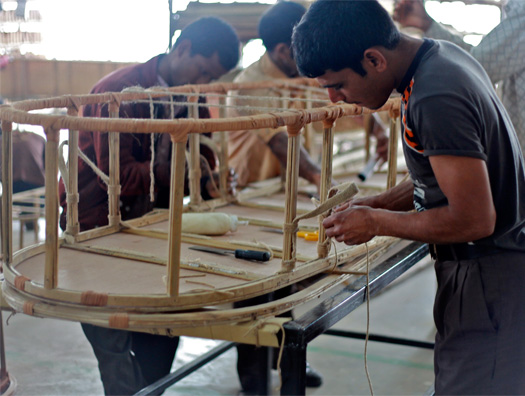May 2015 Update

This is Helena’s story; she is from Bangladesh and is a staff member at Oasis Coffins with responsibility for community impact and Fair Trade. She describes what happened in the production unit the day the Nepal earthquake struck. Our facility in northern Bangladesh is 1000Km from the earthquake epicenter.
For most people living in Nepal, North India, Bangladesh, parts of Bhutan, China and Pakistan, Saturday the 25th of April, 2015 will always be a memorable day, the accounts and stories from which will be shared for weeks if not months and years to come. Like many others, I re-live the moments as we felt the impact of the 7.8 magnitude earthquake in Nepal, 1000 km away from our production centre. I work for Oasis Coffins and was in a meeting on the 2nd floor of our building in Bangladesh’s northern most manufacturing zone.
It was close to noon and I was in a conversation with Shima*, one of the factory production workers. Initially, I paid little attention to the shaking furniture, but as the seconds ticked by, I realized that we were in the throes of quite a long and powerful tremor. When I stopped talking and calmly told Shima what was going on, I saw fear and uncertainty in her eyes, the very emotions I felt but didn’t have the luxury to express (my response might possibly affect that of many others). Outside the room, I heard people shouting and running down the stairs in order to exit the building. As Shima and I joined them, my primary concern was to prevent a stampede. With encouragement from some of us to maintain a calm and orderly descent, everyone was safely downstairs and outside the building in a matter of minutes.
The layout of the buildings within this purpose built area, allows for margins of ample proportion between and in front of factory buildings, making these open courtyards the safest spaces to evacuate to during emergencies such as earthquakes. Once the building had been evacuated, the staff assembled in groups according to their areas of work so that everybody could be accounted for. This was followed by clear instructions to the teams on evacuation procedures in the likely scenario of aftershocks. We had two clear aftershocks in the days following the earthquake, the epicenter of each quake becoming progressively closer to Nilphamari where we were. The epicenter of the last aftershock we felt was only 250km from us in India’s Sikkim
When the earthquake struck, fear and shock registered on most faces. I overheard some of the workers saying that they hadn’t been aware of the earthquake because they had been working on heavy machinery. Had it not been for the alarm raised by some of their co- workers they would not have known at all. Bangladesh is not new to building collapses where many people lose their lives (the most recent shocking and globally publicized being the Rana Plaza factory collapse in 2013). Not far from every employee’s mind are images of destruction and loss of a hope and future that occurs when a building comes down. Poor quality construction can often lead to this but add an earthquake to the mix and it turns lethal. Aware of the need for staff to have the comfort and presence of family after an event such as this, as well as the necessity to evaluate the building, our production was stopped immediately. There were reports of cracks having appeared in parts of the building that warranted expert analysis and advice, and so, the EPZ civil engineer was invited to evaluate the building. His verdict was that any marks were superficial and not structural and only after this was verified and the building deemed safe for work, has production resumed.
It is with pride and gratitude that I say that all our staff and production workers conducted themselves in a worthy manner that ensured safety and life in a time of fear and likely danger.
*Name has been changed to protect the identity of the person.